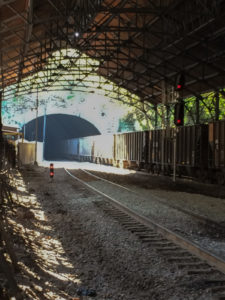
Years of persistence by the Hogan administration have finally paid off, resulting in a grant of $125 million of federal funding through the Infrastructure for Rebuilding America Grant Program (INFRA) administered by the U.S. Department of Transportation. This funding brings Baltimore another critical step closer to the reconstruction of the Howard Street Tunnel (HST).
The HST was originally built in 1890-95 by the B&O Railroad. Now it is owned and used by CSX Transportation (CSX). A rebuilt HST will provide a direct rail route through Baltimore City, rather than the current situation that requires CSX rail cars to go north for hundreds of miles in order to reach midwest and southern markets.
Baltimore needs to rebuild the HST so that trains running through the tunnel can carry double-stacked containers. The practice of double-stacking containers on rail cars began in the 1980s. Today, nearly 75% of intermodal shipments use double-stacking. But rail cars carrying double-stacked containers cannot get through the aging HST. Double stacking of “high cube” containers (each 9.5 feet high) in a well car requires a 20-foot clearance from the top of the rail. After adding in the height of the tracks and the rail car, the 21-foot height of the HST is insufficient by about a foot and a half.
The inability to move double-stack containers through the HST has put the Port of Baltimore at a significant disadvantage compared to other east-coast ports that are reaping the benefits of the recently expanded Panama Canal. This is because there are only two routes out of Baltimore for cargo unladed at the Port: (1) west and south through the HST, or (2) north to Albany. Today it is not economical or practical for CSX to transport double-stacked containers though Baltimore. The Port of Baltimore is not able to realize the potential of significant investments that have already been made, such as dredging the Port to accommodate New Panamax cargo ships and installing New Panamax cranes to serve those ships.
While the grant is a significant step in the right direction, more work remains ahead. The HST reconstruction is projected to cost $466 million. Prior to the INFRA grant, Maryland and CSX each pledged a combined $238 million – $147 million from Maryland and $91 million from CSX – to fund the reconstruction of the HST and 22 other bridges to accommodate double-stacking. There is still a shortfall of slightly over $100 million that must be raised to complete this project. More funding sources are needed. There are other stakeholders who could step up. Ports America Chesapeake which operates Seagirt Marine Terminal, Tradepoint Atlantic, labor unions, and many other maritime business entities in the region have an economic interest in seeing the project through to completion.
Our mayor and City Council need to step up and be more vocal and visible promoting rebuilding the HST. Increased economic activity in the city means more jobs. The Downtown Partnership of Baltimore supported the request for the federal grant. The Baltimore Development Corporation (BDC) is the economic development agency for the City of Baltimore with the mission of expanding businesses and attracting new economic growth to help create jobs in Baltimore. Rebuilding the HST deserves support from the BDC. City leaders should urge BDC to become involved.
Baltimore has many advantages as a port – strong port infrastructure, less congestion than New York and New Jersey, and an inland location closer to the midwest than Norfolk or other southern ports. We need to rebuild the HST to maximize the economic benefits the Port of Baltimore brings to our city and state.
This article was first published on the Op Ed page of the Baltimore Sun on July 31, 2019.
